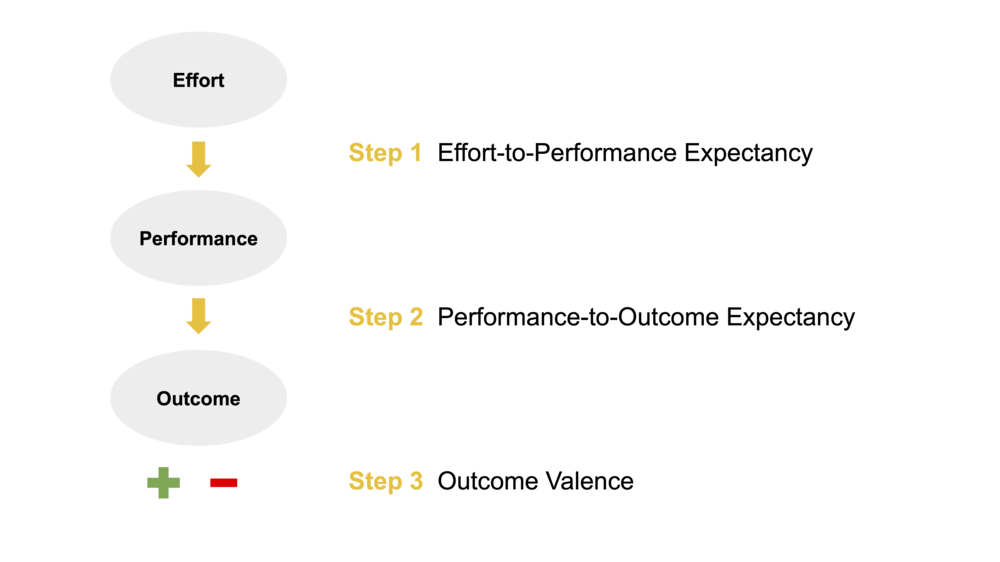
At a glance
The problem: Employee reward programs sometimes don’t have the desired effect on employee performance.
The tool: Expectancy theory examines three influence factors of employee rewards programs on employee performance, regardles of which employee rewards system example you use.
Take action: Enable your team, link rewards to performance and offer rewards your employees value.
Your employee rewards program does not produce the desired outcome?
“My team just isn’t performing as I want them to. I even offered rewards, but they still don’t seem to give everything.”
Ever had the same thought? I’ve heard this quite some times. There’s a structured approach to solve this problem called Expectancy Theory.
It helps understand the factors that make your incentive or employee rewards system work. We want to motivate our employees, that’s the goal. Let’s have a look at how to create a reward program that works.
Now before we jump into the expectancy theory, I want to put this blog post into the bigger picture of purpose and new work: I am a big advocate for fostering intrinsic motivation amongst employees to increase employee engagement and retention.
As Daniel H. Pink describes in his excellent book “Drive”, giving your team the chance to experience autonomy, purpose and mastery can in itself be enough to motivate. A goal worth pursuing.

However, many job profiles don’t allow for catering to all three pillars of intrinsic motivation. Additionally, a good share of employees does respond to extrinsic motivation such as monetary rewards.
Also, employee rewards are often an expected part of the employee compensation package. I believe that the ideal motivational system is not either-or, but a balanced mix of intrinsic and extrinsic factors.
But no matter what your take on this is: Reward systems for employees and motivation are connected, and if it’s only by positive reinforcement of good behavior through praise or other signs of appreciation.
Expectancy theory
Expectancy theory breaks employee motivation down into three expectancies that your employees might have about their work performance and the rewards they might receive. These questions are:
- If I put in the effort, will I be able to show the desired performance?
- If I show the desired performance, how certain am I that a reward is linked to it?
- How do I like the reward that’s linked to the showing the performance?
All three questions influence your team’s performance. And if the value for one goes down, overall motivation (and thus performance) is likely to go down.
For easier management of the three, you can assign points to each expectancy/question. Ideally, you end up at an overall value of 1.

Based on this, there are three steps you can follow to design an effective reward system for employees:
- Step 1: Make sure your team has everything they need to be successful.
- Step 2: Make sure that there are rewards tied to great performance, and people know that.
- Step 3: Make sure your team values the type rewards you offer.
Let’s break it down into more detail.
Step 1: Effort-to-Performance Expectancy
The first step we look at when examining the effectiveness of a reward program for employees is effort-to-performance expectancy: From your employee’s view, is it likely that he or she will be able to show the desired performance when they put in the effort?
You can assign a point value from 0 (impossible) to 1 (100% sure) to this expectancy.
Equipping your team with everything they need to accomplish their tasks will raise this expectancy. So what can you do?
HIRING THE RIGHT PEOPLE
If you hire people with an adequate skill set, they are more likely to achieve a high level of performance. Equally important, top performers are more likely to know that they can do what you’re asking.
I know that hiring is a whole topic on its own, but it’s the best thing you can do to improve this expectancy in the long run.
TRAINING
If your team lacks the skills it needs to accomplish tasks, that will undoubtedly result in a lower E-to-P expectancy.
Let’s say you want to reward your customer service team based on the number of solved customer requests and they don’t know your product well enough to do that, it won’t work.
Identify the most significant skill and knowledge gaps for the tasks most relevant and offer training measures. You can do that by asking your team for their input, but also use techniques like the Gemba Walk (LINK) to find these gaps.
RESOURCES
Where you allocate resources in your company will determine how well departments and consequently, employees can achieve your tasks. And that’s a biggie for motivation.

We don’t even have to talk about rewards to understand that if you assign tasks or goals to a team member and don’t give her or him the resources – headcount, budget, infrastructure – it will most certainly be a frustrating endeavour for everyone involved.
Try to make sure that your people have the things they need to accomplish their tasks.
ROLE MODELS AND COACHING
E-to-P Expectancy has to do a lot with self-efficacy, i.e. our belief that we are able to handle and master any given situation. It’s not enough to check all the boxes above; your team needs to believe that they can show the desired performance.
You can use role-models from within your company and offer coaching to increase self-efficacy among your team members if necessary. It’s a long shot, but will enable your team on a skill as well as an emotional level to better accomplish their tasks – and raise their expectancy to be able to.
Step 2: Performance-to-Outcome Expectancy
Now that you’ve made sure that your team can perform on the right level, the next step is to look at the expectancy of whether a certain level of performance is linked to an outcome. You want to answer the question: Is there a clear, visible link between performance and reward?
Again, you can assign a point value to this expectancy, ranging from 0 (I am sure there will be no outcome even if I show the performance) to 1 (I am sure there will be an outcome if I show the performance).
Your goal here is to have a clear relationship between performance and outcome/reward, and your team is aware of what that relation is.

MEASURE PERFORMANCE
The first thing you want to do is to measure the performance of your employees. This means to know what performance is for a specific position in your company. If you have a KPI system in place, this will be a great help here.
If not, look at the tasks your employees are doing, define what high performance for a specific task is and discuss this with your employee. Once you are clear on what to measure, set up a system where you or your managers track performance throughout the interval of your reward system (monthly, yearly).
Also, share the information about what you measure with your team. It will be an excellent indicator for your team for what to focus on. But be careful about what you choose – your team will go for it. Take some time to think through potential undesired 2nd or 3rd level consequences.
LINK OUTCOMES
The second thing you want to do is to define a performance-outcome-relation: You want to link rewards to accomplishments. You can do this on an individual level or – if the results you’re looking for can only be achieved through teamwork – on a team level.
Also, there must be a mechanism in place that will periodically or by trigger (think: big sale in a B2B environment) evaluate the performance and assign rewards.
It doesn’t have to be a mathematical and strict rule, but an understandable and transparent mechanism to reward your employee’s achievement.

An easy example is to reward a specific sales volume for your sales rep with a cash bonus at the month-end. But there’s an endless variety of options here: Reward the best result in an internal training measure with an additional $2,000 of training budget for individual use. Or reward high scores on a 360° feedback with a team outing.
CREATE AWARENESS
It’s not enough to have or implement these performance-outcome mechanisms; your team also must be aware of their existence and ideally experience them regularly. Use anecdotes, reward ceremonies or such to display the link between performance and outcome frequently.
Step 3: Outcome Valence
Now your employees are sure they can perform well and know that there will be a reward, but there’s still something left to consider: the so-called outcome valence, i.e. the question of whether your employees value the outcomes linked to a task or not.
This expectancy is the only one of the three that can be negative, ranging from -1 (the outcomes/rewards cause negative feelings) to 1 (I highly value the outcomes). What can you do to optimize this expectancy?
MAKE SURE YOU OFFER REWARDS THAT YOUR EMPLOYEES VALUE
That sounds trivial, but it is not. The variety of possible rewards is enormous, from non-monetary to monetary, from individual to team, from immediate to long-term etc. Make sure whatever you choose is valued by your employees.
If you are not sure what valued outcomes are for your team, you might as well ask them, but make sure to manage expectations amongst your team: This is about collecting information, not a guarantee that you will grant every single wish.

INDIVIDUALIZE EMPLOYEE REWARDS
One size does not fit all when it comes to rewards. If you can manage the overhead, a certain degree of individual choice in the rewards your employees receive will increase the chance that there’s something for everyone.
For example, you could offer three different reward packages, ranging from cash or gift cards over additional paid leave to an employee stock options plan. This way, with all three of them designed to cost you the same, you will still increase the outcome valence for many of your employees.
BEWARE OF COUNTERVALENT OUTCOMES
There might be situations where you unintentionally choose rewards that have a negative valence for your employees and thus will harm their motivation.
Example: While peer recognition will be generally a good thing, your introverted bookkeeper might not be too happy about being on stage during an employee of the month ceremony. Try your best to identify and avoid rewards that have a negative outcome valence.
All three steps are important
If you multiply your performance in those three expectancy categories, you will arrive at a point value on how your performance and reward system contributes to your employee motivation. The absolute value has no significance, but if you repeat the exercise over time, you will see if you move in the right direction.

As mentioned earlier, getting this right (especially the effort to performance expectancy) also helps to foster intrinsic motivation, as it enables your team to be good at what they do and believe in themselves.
Additionally, for many people, the money they earn serves a somewhat intrinsically motivating purpose: It is a measure of achievement.
I know that some research shows that extrinsic rewards can be harmful to intrinsic motivation. Then there’s other research that does not find this connection. So as long as you decide to work with a reward system, get these three things right:
- Make sure your team can accomplish what you want from them, and they know it.
- Tie rewards to high performance and make sure people have transparency over performance metrics and rewards.
- Choose rewards that people actually value. If you’re not sure what these are, ask your team.
TEAM-BASED AND ORGANIZATIONAL LEVEL REWARDS
If individual roles in your company are deeply interdependant and your employees can reach their goals only as a team, it makes sense to consider team-based or even company-level rewards.
This means that you will set goals or performance metrics for a whole team instead of individuals and then reward thos outcomes.
How does expectancy theory work here? If your team roles are very interdependant, usually the effort-to-performance expectancy is lower: As no individual can influence the actual performance only with their own effort, there is no strong link between effort and performance.
If you acknowledge this fact and implement team-based rewards, the performance-to-outcome expectancy increases: Each individual sees that realistically achievable and measurable performance is linked to a clear outcome.
In this way, the higher performance-to-outcome expectancy may compensate for the lower effort-to-performance expectancy.
If your team is highly interdependant, choose team-based rewards.
You can still use individualized outcomes with team-based rewards, e.g. if you use a points system for the rewards that can translate either into cash or days-off.
As always, if you have questions or want to share your own experience with reward systems and motivation, please use the comment section below.
Best
Benjamin

